Amidst the cultural and political ferment of the 1960s, avant-garde artists and architects began embracing biological and scientific models as well as the potentials of emerging technologies to explore radical new directions in urban design, developing projects that were at once fanciful, complex and conceptually serious.
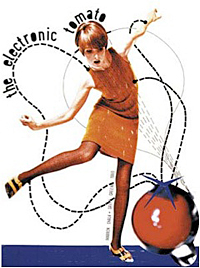
Warren Chalk and David Greene, *Electronic Tomato — Collage,” 1969. Ink, tape, newsprint and felt-tip pen, 28 3/8 x 20 1/2″. Courtesy of Archigram Archives.
This fall the Mildred Lane Kemper Art Museum at Washington University in St. Louis will present Metabolic City, an exhibition surveying work by the British collective Archigram; the Japanese Metabolists (whose members include Fumihiko Maki, architect of the Kemper Art Museum); and the Dutch painter Constant Nieuwenhuys, an early member of the Situationist International.
Curated and designed by Heather Woofter, assistant professor of architecture in the Sam Fox School of Design & Visual Arts, Metabolic City will feature approximately 70 drawings, plans, models and conceptual projects, including rarely seen materials drawn from private archives and a sampling of work by influential predecessors.
Organized thematically, the exhibition explores theoretical and conceptual overlaps between these groups, all of which came to view the city as a kind of living organism, in which civil infrastructure forms the basis for social interaction and individual liberty. At the same time, though they articulated their views in explicitly political terms, each pioneered distinctive — and remarkably prescient — means of architectural representation, often employing techniques and processes that are only now entering mainstream practice.
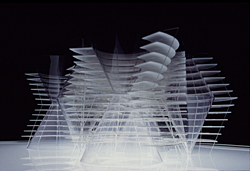
Fumihiko Maki, *Golgi Structure,* 1967. Digital photograph of model. Courtesy of Maki and Associates.
Networks of urban circulation were a major area of focus. Mechanical systems, roadways, pedestrian passages and other built environments frequently were conceived in relation to electronics, media and other immaterial connections. Archigram’s Computer City (1964), for instance, tracks the infrastructures that allow its futuristic Plug-In City (1962-64) to operate. Maki’s Golgi Structures (1968) — named for Nobel Prize-winner Camillo Golgli, who developed techniques for visualizing nerve cell bodies — alternate dense urban areas with unstructured open spaces. Encasing the latter are light-absorbing cells that facilitate communication, energy distribution and mechanical systems.
These figures also shared a belief that adaptable habitats could foster unprecedented levels of freedom and mobility. Archigram’s Walking City (1964) consists of mammoth “pods,” or cities built as ship-like vessels, capable of traversing the earth. Nieuwenhuys’ New Babylon North (1960) suggests a sprawling serpentine structure that could be shaped and reshaped by inhabitants, their labors supported by factories hidden below ground. Wall City (1960), by the Metabolist Kisho Kurokawa, envisions a series of movable plug-in units for living and working, the increased efficiency of which would shorten the workweek and encourage leisure travel.
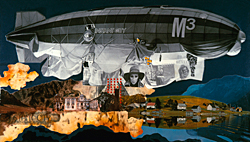
Peter Cook, *Instant City — Airship M3,* 1968. Collage of photographs and newsprint, overdrawn, 40 1/8 x 28 3/8″. Courtesy of Archigram Archives.
Growth patterns and life cycles are a part of all living systems, an observation that deeply influenced Kurokawa’s Metamorphosis (1965), which employs techniques derived from biological modeling to represent the transformation of urban spaces. Growth patterns of a media-based variety inform Archigram’s utopian Instant City (1960), in which large airships descend onto population centers to install infrastructure supporting community events, ranging from circuses to political rallies. As the airships move on to other locations, those infrastructural networks remain behind.
Underlying many projects was a hopeful yet critical view of new engineering technologies. Though this generation of artists and architects witnessed the effects of World War II and the mass destruction made possible by technological inventions, the emerging space age nevertheless sparked a sense of optimism and potential. For his Marine City (1961), the Metabolist Kiyonori Kikutake collaborated with marine engineers to detail entire metropolises constructed out at sea. Comprised of multiple towers connected in a ring, these structures would submerge beneath the waves during inclement weather and return safely to the surface as waters grew calm.
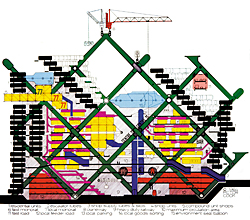
Peter Cook, *Plug-in City Study — Overhead view,* 1964. Print off ink on tracing drawing with added color, 40 1/8 x 28 3/8″. Courtesy of Archigram Archives.
MILDRED LANE KEMPER ART MUSEUM
The Mildred Lane Kemper Art Museum, part of Washington University’s Sam Fox School of Design & Visual Arts, is committed to furthering critical thinking and visual literacy through a vital program of exhibitions, publications and accompanying events. The museum dates back to 1881, making it the oldest art museum west of the Mississippi River. Today it boasts one of the finest university collections in the United States.
Metabolic City will open with a reception from 7 to 9 p.m. Friday, Sept. 18, and remain on view through January 4, 2010. Both the reception and exhibition are free and open to the public. The Kemper Art Museum is located on Washington University’s Danforth Campus, near the intersection of Skinker and Forsyth boulevards. Regular hours are 11 a.m. to 6 p.m. Mondays, Wednesdays and Thursdays; 11 a.m. to 8 p.m. Fridays; and 11 a.m. to 6 p.m. Saturdays and Sundays. The museum is closed Tuesdays. For more information, call (314) 935-4523 or visit kemperartmuseum.wustl.edu.
In conjunction with the exhibition Dennis Crompton, a former member of Archigram, will host a gallery talk at 2 p.m. Sept. 19 in the Kemper Art Museum. Crompton — who also will attend the opening reception — spent last fall teaching in the Sam Fox School as the Ruth and Norman Moore Visiting Professor of Architecture.
Editor’s Note: High-resolution images available upon request.
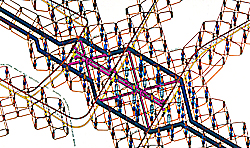
Dennis Crompton, *Computer City Project — Axonometric,* 1964. Photoprint from ink drawing with added color film, 40 1/8 x 28 3/8″. Courtesy of Archigram Archives.
|
WHO: Mildred Lane Kemper Art Museum WHAT: Exhibition, Metabolic City WHEN: Sept. 18 to Jan. 4, 2010; Opening 7 to 9 p.m. Friday, Sept. 18. WHERE: Mildred Lane Kemper Art Museum, Washington University, near the intersection of Forsyth and Skinker boulevards HOURS: 11 a.m. to 6 p.m. Monday, Wednesday and Thursdays; 11 a.m. to 8 p.m. Fridays; 11 a.m. to 6 p.m. Saturday and Sunday. Closed Tuesdays. COST: Free INFORMATION: (314) 935-4523 or kemperartmuseum@wustl.edu |